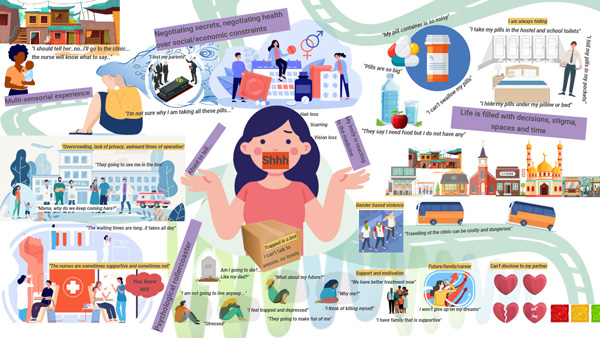The place of art in the evidence ecosystem to address health equity
Introduction
On World Evidence-Based Healthcare Day 2023, we celebrate the importance of ‘evidence and global health equity’. The aim of this global initiative is to raise awareness of the need for better evidence to inform healthcare policy, practice and decision-making to improve health outcomes globally. Evidence-based healthcare relies strongly on rigorous research and data to guide decisions, and evidence ecosystems are the backbone of equitable health policies, systems and services. In the pursuit of health equity, we must also recognise the valuable role that art can play in the evidence ecosystem. This blog explores the intersection of art, health equity and evidence-based healthcare, highlighting how using art can bridge gaps, foster inclusivity and contribute to the evidence ecosystem.
Art as a catalyst for health equity
Health equity is a central goal in healthcare, aiming to ensure that everyone can attain their highest level of health. Achieving health equity goes beyond addressing medical conditions; it also involves addressing social and environmental determinants of health, such as poverty, education, access to green spaces and access to healthcare. Art-inspired approaches can play a crucial role in this endeavour. The use of art to document, make sense of and communicate history is a timeless practice that has evolved throughout human history, from the ancient rock paintings of our ancestors to intricate and thought-provoking modern-day artworks. Art, in all its forms, transcends cultural and language barriers and offers us a unique lens through which we can explore, reflect upon and connect with our experiences. The use of art in the evidence ecosystem allows us to amplify voices, raise awareness and build empathy in the following ways:
Amplifying voices: Art serves as a medium through which marginalised voices can be amplified. Artistic expressions can shed light on social injustices, health disparities and the lived experiences of disadvantaged communities.
Raising awareness: Art has the power to raise awareness about health issues that are often overlooked. Through visual art, performances and storytelling, artists can draw attention to conditions and challenges faced by under-served populations.
Building empathy: Art can foster empathy by allowing individuals to connect emotionally with the experiences of others. This emotional connection can be a powerful driver for change and advocacy.
The power of art-based approaches in practice
For the last four years, with the support of VLIR-UOS, KU Leuven and Stellenbosch University, I have committed my time to working with young women with perinatal infections of human immunodeficiency virus (HIV) in Cape Town, South Africa. Informed by the evidence through systematic reviews, we identified a gap in evidence for young people living with perinatal infections of HIV in the Global South and their adherence to antiretroviral treatment.
In a follow-up qualitative evidence synthesis, we included the arts-based approach of storyboarding as a means of analysis and uncovered that, for young people, treatment adherence has less to do with people’s preferences, motivations, needs and dispositions, and more to do with how bodies, viruses, things, ideas, institutions, environments, social processes and social structures come together. Treatment adherence is, in fact, a multisensorial experience; a discovery that was not as apparent using traditional means of analysis.

This discovery informed the primary research for a group of young women living in Cape Town, and we adopted a participatory, arts-based approach using paint, decoupage, dance, body mapping, community mapping, photography and film. We aimed to explore the multisensory experience of their homes, communities and healthcare settings, and how these affected their treatment adherence. Additionally, we incorporated their stories into the storyboard from our review. We produced a full-length documentary, More than a Pill, which was able to communicate these stories authentically and visually. This documentary was screened to policymakers, educators, healthcare workers, community members and the public as a means of igniting conversations, raising awareness and advocating for young women. Using these methods, we could triangulate primary and secondary data, engage with review findings with ease across language barriers, and create primary evidence that could be used for advocacy and decision-making.
Art-inspired praxis in the evidence ecosystem
Art, and the praxis inspired by it, has a place in all components of evidence ecosystems, including production, implementation, dissemination, evaluation, advocacy, decision-making and education. Many of the ways we design, conduct and share research already include art-based tools and inspired activities. There are many ways to integrate and harness the power of art in the evidence ecosystem:
Data visualisation through art: Art can be a powerful tool for visualising complex healthcare data. Infographics, diagrams and interactive artworks can help convey information more intuitively to diverse audiences, making the data more accessible and compelling to policymakers and the public.
Storytelling and creative data: Data in the form of personal stories and narratives can be impactful and artistic expressions, such as storytelling, poetry or visual arts, can often convey the human experiences behind quantitative statistics. These narratives can shed light on the emotional, cultural and societal dimensions of health equity issues.
Art-based research methods: Researchers can incorporate artistic methods into their studies to gain a deeper understanding of health-related phenomena; for example, photovoice projects empower participants to document their communities' health challenges through photography and then discuss their findings.
Art as a tool for advocacy: Advocacy is a critical component of promoting health equity. Art can be used to create compelling campaigns and materials that raise awareness and mobilise support for equitable healthcare policies. Creative expressions, such as posters, murals and public performances, can serve as powerful advocacy tools.
Public engagement and public art installations: Engaging communities through art projects fosters participation and empowerment. Large-scale art installations in public spaces can serve as powerful reminders of health issues and disparities. These installations can prompt discussions, engage the public and encourage civic action. Evidence of their impact can be collected through surveys, visitor feedback and changes in public attitudes and behaviours.
Collaborative and transdisciplinary partnerships: Building bridges disciplines can lead to innovative projects that combine artistic creativity with scientific rigour. These collaborations can result in research studies, exhibitions or performances that generate valuable evidence on the intersection of art and health equity.
Art-based education and training: Healthcare professionals can benefit from art-based education and training programs that enhance their cultural competence and empathy. Workshops that involve engaging with art can help healthcare providers better understand the diverse backgrounds and needs of their patients, ultimately leading to more equitable care.
Artificial Intelligence (AI) and art: Emerging technologies, such as AI, can be used to analyse art-related data. For instance, AI algorithms can be trained to recognise emotions conveyed through art or analyse artistic expressions in a specific cultural context. These data can contribute to a deeper understanding of mental health, cultural influences and social determinants of health.
Conclusion
Art is a powerful tool for promoting health equity. The key message is that art, with its healing and transformative powers, belongs at the heart of the evidence ecosystem. The use of art to produce, implement, disseminate, evaluate, collaborate, advocate, educate and make decisions creates inclusive spaces that amplify voices, prioritises the under-represented, and allows for multiple ways of knowing that cross boundaries and languages. By embracing art and art-inspired research and data as a legitimate form of evidence in healthcare, we can work towards a more inclusive, empathetic and equitable healthcare system for all.
Disclaimer
The views expressed in this World EBHC Day Blog, as well as any errors or omissions, are the sole responsibility of the author and do not represent the views of the World EBHC Day Steering Committee, Official Partners or Sponsors; nor does it imply endorsement by the aforementioned parties.
